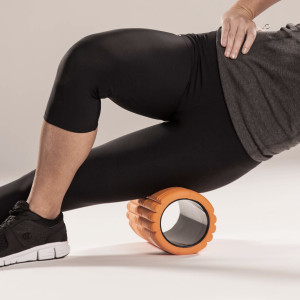Five Best Exercises for Athletes Recovering from a Knee Injury
 Knee injuries are extremely common among all athletes, both those who play recreationally and those who are seasoned professionals.
Knee injuries are extremely common among all athletes, both those who play recreationally and those who are seasoned professionals.
Patriots quarterback Tom Brady has experienced both a torn ACL and a torn MCL, as has his teammate Rob Gronkowski. Olympian Alex Morgan also suffered from a torn ACL when she was senior in high school.
None of these athletes let their knee injuries stop them, and neither should you. No matter what kind of knee injury you’re dealing with, these exercises can help you get back on your feet.
1. Foam Rolling for the Shins
Foam rolling is a great technique for loosening up the muscles and promoting recovery after tough workouts.
When most people think about foam rolling, they focus on the glutes, quadriceps, and hamstrings. But, it’s also important to spend some time rolling the shins, especially if your sport of choice requires you to do a lot of running — track, soccer, basketball, etc.
Foam rolling the shins helps relieve tension that could irritate the knees. It also helps prevent shin splints — win-win!
To foam roll the shins properly, start on all fours and place the foam roller at the base of the ankles. Then, slowly roll upward, pausing when you reach a tender spot. Hold your weight on each spot for 30-45 seconds before moving on.
2. Straight Leg Raises
This is a great exercise for athletes who struggle with chondromalacia, a condition, also known as runner’s knee, that affects the cartilage in the knee.
Straight leg raises target the quadriceps. When the quads are strong, there’s less pressure on the knee joint when you’re running, walking, and jumping.
To do straight leg raises properly, simply sit up straight — you can use a wall for support if necessary — and place your hands behind you for support. Flex your feet and lift your right leg up about six inches off the ground. Keep your leg as straight as possible (but avoid hyperextending your knee). Lower it slowly back to the ground.
Repeat for 10-15 repetitions, then switch sides. Complete three sets total.
3. Step Ups
This is another great exercise that targets the quadriceps, hamstrings, and the glutes. When all of the muscles are equally strong, your risk of knee injury significantly decreases.
To do step ups, you can use a bench, a sturdy box, or the lowest stair on your staircase. Simply place your right foot on the bench, box, or stair, then press into that foot and lift yourself up, keeping the pelvis straight and gaze neutral.
Avoid using your bottom foot to push off the ground (this makes the exercise easier and stops your legs from getting as much attention as they should).
Slowly lower yourself back down, then step up again. Repeat for 10-15 repetitions, then switch sides. Complete three sets total. You can also hold dumbbells to make this exercise more challenging.
4. Clamshells
This exercise strengthens the hips and outer glutes. This helps you correct poor movement patterns like overpronation, which can lead to knee injuries if left untreated.
To do clamshells correctly, start by lying on your right side with your knees stacked on top of each other bent at a 90-degree angle. Your hips should also be flexed to an angle of approximately 60 degrees.
Press your heels together, keep your hips stacked, and slowly lift your left knee toward the ceiling. When you’ve lifted it as high as you can, hold for a couple of seconds, then repeat for 10-15 repetitions and switch sides. Complete two or three sets total.
5. Deadlifts
Deadlifts are a great compound exercise that targets a number of muscles throughout the body, including the hamstrings, calves, glutes, and quadriceps — all muscles that need to be balanced to prevent knee injuries.
The deadlift is a more advanced exercise and should only be attempted if you’re an experienced weightlifter — or if you have a personal trainer or coach who can teach you proper form.
To deadlifts properly, stand behind a barbell with your feet shoulder-distance apart. Hinge at the hips to pick up the barbell, keeping your chest lifted and your back and arms straight.
Keep a slight bend in your knees, but don’t bend them like you would if you were doing a squat. Make sure your abdominals are engaged, too, to support your lower back.
Repeat for 6-8 repetitions and complete between three and five sets total.
You can also do deadlifts with dumbbells if you don’t have access to a barbell.
Conclusion
It’s not totally possible to prevent knee injuries — accidents happen, even to the most skilled athletes. But, you can significantly decrease your risk of experiencing an injury by incorporating these five exercises into your training regimen.












